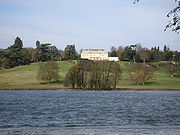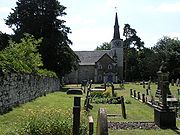
Gatton Park
Encyclopedia

Parkland
Parkland or Parklands may refer to:* A park* Aspen parkland, a biome transitional between prairie and boreal forest * Landscaped parkland, a managed rural area associated with European country houses such as Longleat-Place names:United States...
near Gatton
Gatton
Gatton may refer to:Places:*Gatton, Queensland, Australia**Shire of Gatton, former administrative region*Gatton, Surrey, former village in England** Gatton , rotten borough based in the villagePeople:...
in Surrey
Surrey
Surrey is a county in the South East of England and is one of the Home Counties. The county borders Greater London, Kent, East Sussex, West Sussex, Hampshire and Berkshire. The historic county town is Guildford. Surrey County Council sits at Kingston upon Thames, although this has been part of...
, England
England
England is a country that is part of the United Kingdom. It shares land borders with Scotland to the north and Wales to the west; the Irish Sea is to the north west, the Celtic Sea to the south west, with the North Sea to the east and the English Channel to the south separating it from continental...
.
Now owned by The Royal Alexandra and Albert school
The Royal Alexandra and Albert School
The Royal Alexandra and Albert School is a co-educational, comprehensive, state maintained boarding school located in Reigate, Surrey. The current, full-time headmaster is Mr. Paul Spencer Ellis...
, Gatton Park constitutes 250 acres (1 km²) of manor
Demesne
In the feudal system the demesne was all the land, not necessarily all contiguous to the manor house, which was retained by a lord of the manor for his own use and support, under his own management, as distinguished from land sub-enfeoffed by him to others as sub-tenants...
and parkland. The property is Grade II listed and is in part administered by the National Trust
National Trust for Places of Historic Interest or Natural Beauty
The National Trust for Places of Historic Interest or Natural Beauty, usually known as the National Trust, is a conservation organisation in England, Wales and Northern Ireland...
. The manor's history can be traced to the Domesday Book
Domesday Book
Domesday Book , now held at The National Archives, Kew, Richmond upon Thames in South West London, is the record of the great survey of much of England and parts of Wales completed in 1086...
of 1086.
The manor of Gatton had the privilege granted in 1451 of sending two members to Parliament, a privilege it retained, as a "rotten borough
Rotten borough
A "rotten", "decayed" or pocket borough was a parliamentary borough or constituency in the United Kingdom that had a very small electorate and could be used by a patron to gain undue and unrepresentative influence within Parliament....
" until the Parliamentary reform of 1832
Reform Act 1832
The Representation of the People Act 1832 was an Act of Parliament that introduced wide-ranging changes to the electoral system of England and Wales...
. During the medieval period the manor demesne
Demesne
In the feudal system the demesne was all the land, not necessarily all contiguous to the manor house, which was retained by a lord of the manor for his own use and support, under his own management, as distinguished from land sub-enfeoffed by him to others as sub-tenants...
was enclosed as a deer
Deer
Deer are the ruminant mammals forming the family Cervidae. Species in the Cervidae family include white-tailed deer, elk, moose, red deer, reindeer, fallow deer, roe deer and chital. Male deer of all species and female reindeer grow and shed new antlers each year...
park
Medieval deer park
A medieval deer park was an enclosed area containing deer. It was bounded by a ditch and bank with a wooden park pale on top of the bank. The ditch was typically on the inside, thus allowing deer to enter the park but preventing them from leaving.-History:...
.
In the 17th century, the house is mentioned as being in the possession of John Weston of Sutton Place, Surrey
Sutton Place, Surrey
Sutton Place, 3 miles NE of Guildford in Surrey is a Grade I listed Tudor manor house built c.1525 by Sir Richard Weston, courtier of Henry VIII. It is of great importance to art history in showing some of the earliest traces of Italianate renaissance design elements in English architecture. In...
(the second and eldest surviving son of Sir Richard III Weston
Richard Weston (1591-1652)
Sir Richard III Weston was an English canal builder and agricultural improver. He instigated the construction of the Wey Navigation one of the first man-made navigations in Britain and introduced new plants and systems of crop rotation....
) and his wife, Mary Copley (daughter and heiress of William Copley of Gatton) until 1654.
About 1748 Sir James Colebrooke acquired Gatton Park from William Newland, with the proprietorship of the borough of Gatton, and his brother Sir George Colebrooke had the park landscaped by Capability Brown
Capability Brown
Lancelot Brown , more commonly known as Capability Brown, was an English landscape architect. He is remembered as "the last of the great English eighteenth-century artists to be accorded his due", and "England's greatest gardener". He designed over 170 parks, many of which still endure...
between 1762 and 1768.
In 1830, Gatton was purchased by Frederick John Monson, 5th Baron Monson
Baron Monson
Baron Monson, of Burton in the County of Lincolnshire, is a title in the Peerage of Great Britain. It was created in 1728 for Sir John Monson, 5th Baronet. The Monson family descends from Thomas Monson, of Carleton, Lincolnshire. He sat as Member of Parliament for Lincolnshire, Castle Rising and...
(1809-1841), for £100,000, for the ancient privilege of sending two members to the House of Commons, a perquisite that was cancelled two years later, "and all Lord Monson had for £100,000 was the land". He set about remaking Gatton Hall splendid: for him Thomas Hopper made alterations to Gatton, and further plans that were not executed. The Marble Hall at the center of the main block was revetted in marbles, even to the inlaid marbles of its floor, taking as a general model the Corsini Chapel in San Giovanni in Laterano, though Lord Monson did not cap his hall with a dome. The walls were frescoed by Joseph Severn
Joseph Severn
Joseph Severn was an English portrait and subject painter and a personal friend of the famous English poet John Keats...
with the Four Classical Virtues, embodied by historical ladies. Gatton church, essentially a chapel for the Hall that is reached from the house by a covered walkway, was richly improved within its simple exterior with imported woodwork at the same time (1834): the pulpit and altar, bought from Nuremberg
Nuremberg
Nuremberg[p] is a city in the German state of Bavaria, in the administrative region of Middle Franconia. Situated on the Pegnitz river and the Rhine–Main–Danube Canal, it is located about north of Munich and is Franconia's largest city. The population is 505,664...
were hopefully attributed at the time to Albrecht Dürer
Albrecht Dürer
Albrecht Dürer was a German painter, printmaker, engraver, mathematician, and theorist from Nuremberg. His prints established his reputation across Europe when he was still in his twenties, and he has been conventionally regarded as the greatest artist of the Northern Renaissance ever since...
; the carved doors came from Rouen
Rouen
Rouen , in northern France on the River Seine, is the capital of the Haute-Normandie region and the historic capital city of Normandy. Once one of the largest and most prosperous cities of medieval Europe , it was the seat of the Exchequer of Normandy in the Middle Ages...
; the presbytery stalls from a disestablished monastery in Ghent
Ghent
Ghent is a city and a municipality located in the Flemish region of Belgium. It is the capital and biggest city of the East Flanders province. The city started as a settlement at the confluence of the Rivers Scheldt and Lys and in the Middle Ages became one of the largest and richest cities of...
, the altar rails came from Tongeren; stained glass for the windows, and the wainscoting of the nave and carved canopies came from Aarschot
Aarschot
Aarschot is a city and municipality in the province of Flemish Brabant, in Flanders, one of the three regions of Belgium. The municipality comprises the city of Aarschot proper and the towns of Gelrode, Langdorp and Rillaar. On January 1, 2006 Aarschot had a total population of 27,864...
, near Leuven
Leuven
Leuven is the capital of the province of Flemish Brabant in the Flemish Region, Belgium...
.

Nikolaus Pevsner
Sir Nikolaus Bernhard Leon Pevsner, CBE, FBA was a German-born British scholar of history of art and, especially, of history of architecture...
"perhaps the best example in the country of the tendency for the church to become an extension of the landlord's parlour or sculpture gallery."
The estate was purchased in 1888 by Sir Jeremiah Colman
Sir Jeremiah Colman, 1st Baronet
Sir Jeremiah Colman, 1st Baronet was a well-known industrialist who developed Colman's Mustard into an international concern.-Career:...
whose family had established the Colman's mustard
Colman's
Colman's is a UK manufacturer of mustard and various other sauces, based at Carrow, in Norwich, Norfolk. Presently an operational division of the multinational Unilever company, Colman's is one of the oldest existing food brands, famous for a limited range of products, almost all varieties of...
food brand in the early 19th century.
After a period when the property was requisitioned during the Second World War the estate was purchased by the current owners, the Royal Alexandra and Albert School.
External links
- Gatton Park website
- the Royal Alexandra and Albert School
- Gatton Park Education website
- Gatton Park at GreatBritishGardens.co.uk
- Gatton Park at VisitSurreyHills.com
- Gatton Hall, Redhill

